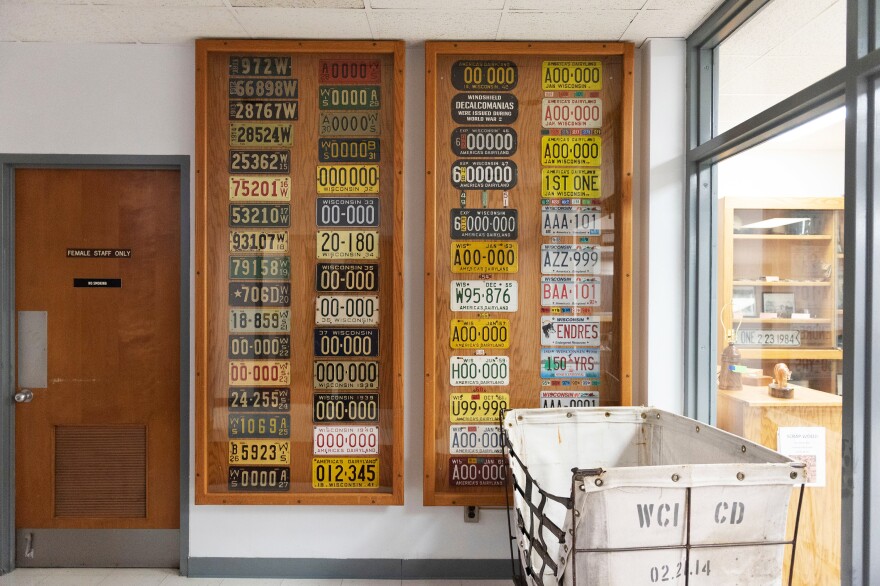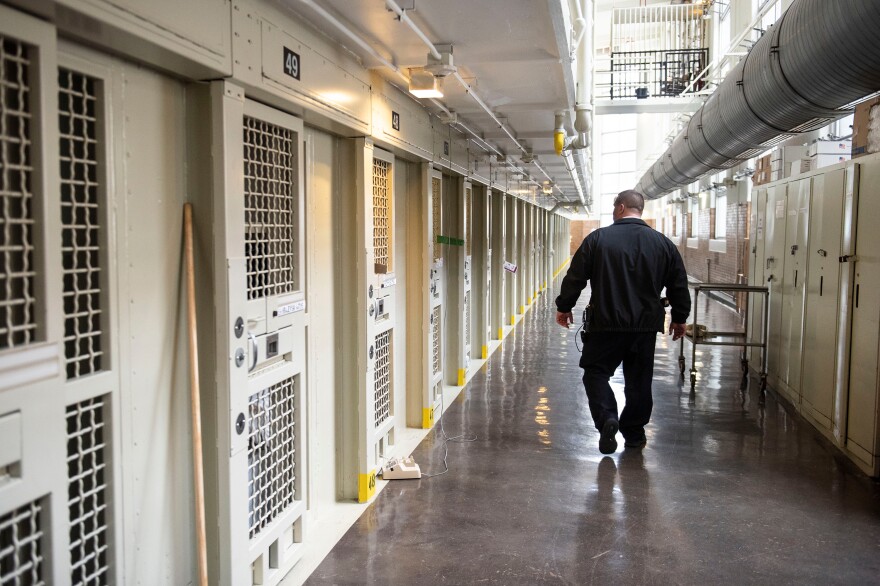Robert Alexander has been away from home for more than a decade. His days and nights are spent locked up behind walls topped with barbed wire.
"Prison kind of gives you that feeling that you're like on an island," says Alexander, 39, who is studying for a bachelor's degree in biblical studies while serving his third prison sentence.
Clad in an oversized gray sweatshirt under the fluorescent lights inside the visiting room of Wisconsin's oldest state prison, he is more than 70 miles from his last address in Milwaukee.
"You don't feel like a resident of anything," he adds.
But if Alexander and his more than 1,200 fellow prisoners are still incarcerated at Waupun Correctional Institution next Census Day — April 1 — the Census Bureau will officially consider them residents of Waupun, Wis., for the 2020 national head count.
That's because, since the first U.S. census in 1790, the federal government has included incarcerated people in the population counts of where they're imprisoned. This technical detail of a little-known policy can have an outsized impact on prison towns across the U.S. for the next decade.

In many cases, rural, predominantly white towns see their population numbers boosted by population counts from prisons disproportionately made up of black and Latinx people.
In turn, states, which control how voting districts are drawn, and local governments can use those numbers to form districts filled predominantly with people who are locked behind bars and cannot vote in almost all states. .
Officials in some prison towns have come up with creative ways to avoid forming voting districts made up primarily of prisoners. But in many others, political lines are drawn around prisons in a way that critics deride as "prison gerrymandering."
Loading...
Split along partisan lines
A recent by Villanova University associate professors highlights the impact this process can have on the political voice of incarcerated people's home communities.
It found a "substantial likelihood" that Philadelphia would gain an additional majority-minority district for Pennsylvania's state house if prisoners incarcerated in the state were counted as residents of their last known addresses.
"The incarcerated are not only missing from their communities," the study's authors, Brianna Remster and Rory Kramer, wrote, but "they are also advantaging other communities."
Still, the issue of where to count prisoners for census numbers has been split largely along partisan lines. Most supporters who want to change the way incarcerated are counted are Democrats, while Republicans generally want to keep things the way they are.
In 2015, when the Census Bureau was about its rules for counting people in prisons, — a prominent Republican redistricting strategist who died in 2018 — warned against adjusting prisoners' numbers.
Hofeller expressed concern that "the actual effect on reapportionment and redistricting is not clearly known for individual states," according to a document Hofeller's daughter, Stephanie, provided to NPR that was copied from his hard drives.
"This change is being encouraged by Democratic or Liberal organizations and could involve the Census Bureau in yet another political conflict," Hofeller wrote in the Microsoft Word document, first .

What worked in 1790 "just doesn't work anymore"
The following year, the bureau received another round of public comments on the issue. More than 99% of the close to 78,000 comments collected in 2016 "suggested that prisoners should be counted at their home or pre-incarceration address," the bureau reported in .
The Census Bureau has said, however, it has no plans to change its policy for the 2020 count.
"Counting prisoners anywhere other than the facility would be less consistent with the concept of usual residence, since the majority of people in prisons live and sleep most of the time at the prison," the bureau .
But some critics say that policy has become out-of-date since it was first implemented for the 1790 census.
"What has changed is just the massive scale of incarceration in the U.S. What worked for the country in 1790 just doesn't work anymore in terms of data methodology," says Aleks Kajstura, legal director of the , a research and advocacy group campaigning to change how incarcerated people are counted. "Even up until the 1970s, the incarcerated population was low enough that it did not impact redistricting when people were counted in the wrong place."
Kajstura also points out that many prisoners are likely to be released or moved to another facility after they're counted for the census. "This facility that they happen to be incarcerated on Census Day is in no way reflective of the reality of where they actually even live and sleep most of the time even by the Census Bureau's own guidelines," Kajstura says.
A piecemeal approach
With the bureau refusing to change its policy, state lawmakers, civil rights groups and other advocates have turned to a piecemeal approach to change how prisoner counts are used to redraw state and local voting districts by advancing legislation and fighting in court.
In May, Nevada and Washington joined California, Delaware, Maryland and New York in passing laws since 2010 requiring relocating prisoners' numbers from where they're incarcerated to their last known home addresses for redistricting.
After the 2020 census, the bureau is planning to help those states recalculate their counts in time for redistricting by releasing data about incarcerated people earlier than it did after the 2010 count.
In Connecticut, state officials are facing a after they used 2010 census numbers counting prisoners where they're imprisoned to redraw voting maps. The country's oldest civil rights organization is arguing in court that the state's redistricting plan has inflated the voting strength of districts of predominantly white voters and violated the 14th Amendment's "one person, one vote" principle, which requires districts to have about the same number of people in them.
"There's no comment"
In Wisconsin — where around 1 in 8 black men age 64 and younger, is behind bars, the — Democratic state lawmakers that would relocate prisoner numbers for redistricting.
If it becomes a law by the time Wisconsin's political maps have to be redrawn after the upcoming census, a major shift in local political representation may be coming to prison towns such as Waupun.
Loading...
In this rural, predominantly white town located northwest of Milwaukee, around 1 in 4 people is incarcerated. It is home to three state prisons, including the facility where every adult male prisoner sentenced to Wisconsin's prison system is processed, .
Together, the three facilities in Waupun house more than 3,000 incarcerated people convicted of a felony, who cannot vote while behind bars. These prisoners make up the majorities in two of the town's voting districts represented by alderpeople on the town's common council.
According to , alderpeople rely on "input from residents" to "ensure a citizen-centered process" when they're making decisions on behalf of the town.
But the elected officials of Waupun's two majority-prisoner districts told NPR that they have never visited the prisons in the areas they represent.
"There's no reason to communicate on property I don't have access to," Alderperson Ryan Mielke, who was reelected this year with 43 votes to represent District 3 — where about 61% of his constituents are incarcerated and cannot vote, according to the Prison Policy Initiative's analysis.
Asked whether he ever wanted to know how many people are in the prison he represents, Mielke replied: "There's no comment."
A spokesperson for Wisconsin Department of Corrections told NPR that elected officials are welcome to visit its facilities. "We have state senators and representatives come through a number of our institutions pretty regularly," said spokesperson Clare Hendricks. "We're welcome to it."

"Almost like your body being used"
Alderperson Peter Kaczmarski represents District 2, where prisoners at Waupun Correctional Institution — a maximum security prison that houses people convicted of violent crimes — make up about 76% of his constituents. Compared with other constituents in his district, Kaczmarski says representing constituents who are behind bars is very different.
"You almost have to think for them because you don't, perhaps, have that day-to-day interaction," said Kaczmarski, who lives down the street from Waupun Correctional.
Robert Alexander — who is serving time in Waupun, about an hour-and-a-half drive away from where he was living in Milwaukee — and the three other prisoners NPR interviewed at the facility said they were not previously aware that Kaczmarski was elected to represent them.
"There's no way that he can say what we feel unless he decides to come in and talk to us," he said.
It doesn't sit well with Alexander that he can be counted for political representation in a place he doesn't consider his residence.
"It's almost like your body being used," Alexander said.
An uneasy relationship has been playing out in Waupun as the town's officials try to keep its prisons in the background and attract more tourists and business developers with a rebranding effort featuring taglines such as "Naturally Adventurous."
The three prisons have been a main driver of Waupun's economy for decades. But Kathy Schlieve, Waupun's city administrator, said officials see a trade-off from having incarcerated people included in the town's population count.

"It really dilutes the socioeconomic profile of the community," Schlieve said. "Our postsecondary attainment looks different than maybe what it is for the average citizen here, as does things like our average household income. So even how we think about recruiting retail, it becomes a much bigger challenge when the data's not depicting the reality of the community that's out spending the dollars."
The town's officials commissioned in order to produce a profile showing what Waupun's demographics would look like if the prison population was removed.
Still, Schlieve said that prisoners should be counted as residents of Waupun, in part because the town is providing prisoners with ambulances, as well as police and fire department services.
"What I would say is purely because we are providing those protective services and infrastructure pieces, I think it's appropriate as it is," Schlieve says. "I think we will follow the letter of the law."
Kajstura, the Prison Policy Initiative's legal director, says that by Wisconsin's then-state attorney general puts towns like Waupun in "a bind" in terms of how it has to redraw voting districts. For state and local redistricting, "institutional populations cannot be excluded" from the population count produced by the Census Bureau, according to the opinion.
But Schlieve said in a written statement that Waupun is interpreting to mean that the town has to "count inmates in our community."
In other prison towns around the U.S., however, local officials have devised ways to avoid creating voting districts made up primarily of prisoners. In Kentucky's Oldham County — where two of its districts contain prisons — incarcerated people were excluded from the 2010 census numbers used to redraw the voting map. Officials in Florence, Ariz., avoid the issue altogether by holding at-large elections that allow all voters to choose candidates from the same pool.
Stuck in limbo
Maryland and New York are the first states in the country to relocate their numbers of incarcerated people back to the last known addresses of the prisoners.
After the 2010 census, those states underwent a complicated process to make sure prisoners were matched with the correct home addresses, according to . Four additional states — California, Delaware, Nevada and Washington — plan to implement similar changes after the 2020 count.

But for some prisoners, determining where "home" is can be complicated. After serving their time, many incarcerated people, uprooted for years, do not return to where they were living before they were locked up.
"Wherever they want to send you, they send you. Wherever they want you to be, you be. So it's not a home," says Alexander, who is not expected to be released from Waupun Correctional Institution until 2030. "You're never in a position where you make this home because you're always planning to exit."
NPR data editor Sean McMinn and former intern Koko Nakajima contributed to this report.
Copyright 2023 NPR. To see more, visit https://www.npr.org.







